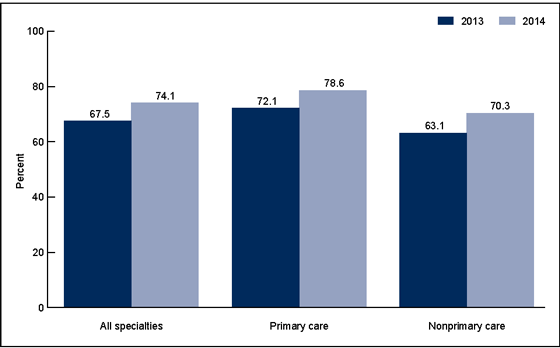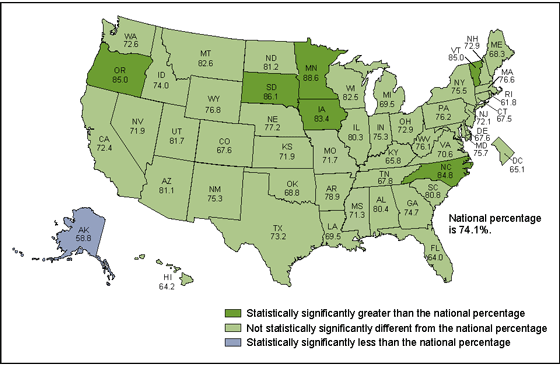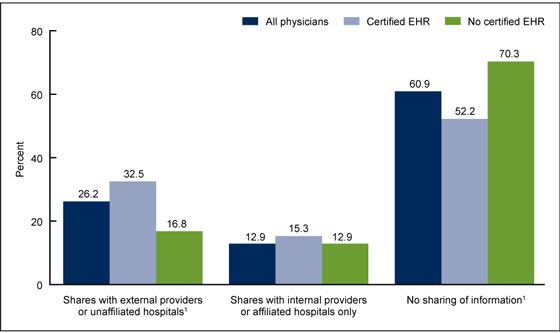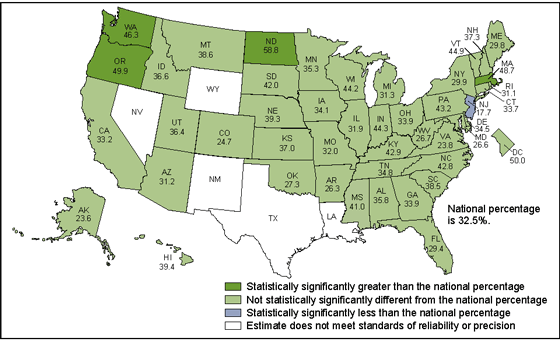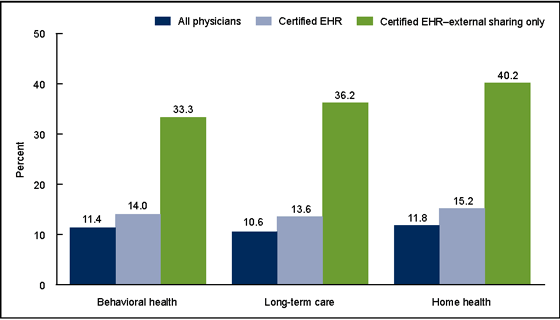Adoption of Certified Electronic Health Record Systems and Electronic Information Sharing in Physician Offices: United States, 2013 and 2014
NCHS Data Brief No. 236, January 2016
On This Page
- Key findings
- Certified EHR systems in physician offices increased from 2013 to 2014.
- Adoption of certified EHR systems in office-based practices varied across states.
- About one-third of office-based physicians with a certified EHR system shared patient health information with ambulatory providers outside their practice or with unaffiliated hospitals.
- Electronic sharing of patient health information with external providers or unaffiliated hospitals by office-based physicians with certified EHR systems varied across states.
- About 15% of physicians with a certified EHR system electronically shared patient information with home health, long-term care, or behavioral health providers.
- Summary
- Definitions
- Data sources and methods
- About the authors
- References
- Suggested citation
Eric W. Jamoom, Ph.D., M.P.H., M.S.; Ninee Yang, Ph.D.; and Esther Hing, M.P.H.
Key findings
Data from the 2014 National Electronic Health Records Survey
- In 2014, 74.1% of office-based physicians had a certified electronic health record (EHR) system, up from 67.5% in 2013.
- The percentage of physicians who had a certified EHR system ranged from 58.8% in Alaska to 88.6% in Minnesota.
- In 2014, 32.5% of office-based physicians with a certified EHR system were electronically sharing patient health information with external providers.
- The percentage of physicians with a certified EHR system electronically sharing patient health information with external providers ranged from 17.7% in New Jersey to 58.8% in North Dakota.
The Health Information Technology for Economic and Clinical Health Act (HITECH) of 2009 provides incentive payments to eligible hospitals and providers that demonstrate the meaningful use of a certified electronic health record (EHR) system (1,2). In 2010, the Office of the National Coordinator for Health Information Technology began certifying EHR systems as having the capabilities that could enable meeting meaningful use criteria (2). This report uses the National Electronic Health Records Survey (NEHRS) to describe physician adoption of certified EHR systems from 2013 to 2014 across the United States and the extent to which physicians with certified EHR systems share patient health information.
Keywords: health information technology, National Ambulatory Medical Care Survey, National Electronic Health Records Survey
Certified EHR systems in physician offices increased from 2013 to 2014.
- In 2014, 74.1% of office-based physicians reported having a certified EHR system, up from 67.5% in 2013 (Figure 1).
- The percentage of primary care physicians with certified EHR systems in 2013 (72.1%) and 2014 (78.6%) exceeded that for nonprimary care specialists in both years (63.1% and 70.3%, respectively).
Figure 1. Office-based physicians with a certified electronic health record system, by physician specialty: United States, 2013–2014
NOTES: Primary care includes family or general practitioners, internists, pediatricians, and obstetricians or gynecologists. Having a certified electronic health record system was defined by physicians answering “yes” to “Does your current system meet meaningful use criteria as defined by the Department of Health and Human Services?” Estimates are based on nonfederal, office-based physicians and exclude radiologists, anesthesiologists, and pathologists. All percentage differences by year and specialty are statistically significant (p < 0.05).
SOURCE: CDC/NCHS, National Electronic Health Records Survey 2013–2014.
Adoption of certified EHR systems in office-based practices varied across states.
- In 2014, the percentage of physicians who had a certified EHR system ranged from 58.8% in Alaska to 88.6% in Minnesota (Figure 2).
- The percentage of physicians who had a certified EHR system was less than the national percentage (74.1%) in Alaska (58.8%) and greater than the national percentage in six states: Iowa (83.4%), North Carolina (84.8%), Oregon (85.0%), Vermont (85.0%), South Dakota (86.1%), and Minnesota (88.6%).
Figure 2. Percentage of office-based physicians who have a certified electronic health record system, by state: United States, 2014
NOTES: Having a certified electronic health record system was defined by physicians answering “yes” to “Does your current system meet meaningful use criteria as defined by the Department of Health and Human Services?” Significance is tested at p < 0.05.
SOURCE: CDC/NCHS, National Electronic Health Records Survey, 2014.
About one-third of office-based physicians with a certified EHR system shared patient health information with ambulatory providers outside their practice or with unaffiliated hospitals.
- In 2014, more than one-third of physicians (39.1%) were electronically sharing patient health information with any ambulatory providers or hospitals. A larger percentage of physicians with a certified EHR system (47.8%) were electronically sharing patient health information with any ambulatory providers or hospitals compared with physicians who did not have a certified EHR system (29.7%) (calculated from Figure 3).
- In 2014, a larger percentage of physicians with a certified EHR system (32.5%) were electronically sharing patient health information with external providers or unaffiliated hospitals than were physicians who did not have a certified EHR system (16.8%) (Figure 3).
- In 2014, a larger percentage of physicians who did not have a certified EHR system (70.3%) were not sharing patient health information with any ambulatory providers or hospitals compared with physicians with a certified EHR system (52.2%).
- For physicians that were only sharing with internal providers or affiliated hospitals (12.9%), no statistical difference was observed based on having a certified EHR system.
Figure 3. Office-based physicians with electronic health record systems who shared patient health information electronically with other providers, by certified electronic health record system status: United States, 2014
1Differences between physicians with and without a certified system were significant; significance is tested at p < 0.05.
NOTES: Having a certified electronic health record (EHR) system was defined by physicians answering “yes” to “Does your current system meet meaningful use criteria as defined by the Department of Health and Human Services?” Sharing patient health information is defined as the electronic sharing of information such as lab results, imaging reports, problem lists, and medication lists. Sharing with external providers or unaffiliated hospitals is defined as sharing with either ambulatory care providers outside their group or hospitals with which their practice is not affiliated. Sharing with internal providers only is defined as sharing with providers inside their group or hospitals with which their practice is affiliated.
SOURCE: CDC/NCHS, National Electronic Health Records Survey, 2014.
Electronic sharing of patient health information with external providers or unaffiliated hospitals by office-based physicians with certified EHR systems varied across states.
- In 2014, the percentage of physicians with a certified EHR system who shared patient health information electronically with external providers ranged from 17.7% in New Jersey to 58.8% in North Dakota (Figure 4).
- The percentage of physicians with a certified EHR system who shared patient health information electronically with external providers was significantly less than the national percentage (32.5%) in New Jersey (17.7%) and significantly greater than the national percentage in four states: Washington (46.3%), Massachusetts (48.7%), Oregon (49.9%), and North Dakota (58.8%).
Figure 4. Percentage of office-based physicians with a certified electronic health record system who shared patient health information electronically with external providers or unaffiliated hospitals, by state: United States, 2014
NOTES: Having a certified electronic health record system was defined by physicians answering “yes” to “Does your current system meet meaningful use criteria as defined by the Department of Health and Human Services?” Sharing patient health information is defined as the electronic sharing of information such as lab results, imaging reports, problem lists, and medication lists. Sharing with external providers or unaffiliated hospitals is defined as sharing with either ambulatory care providers outside their group or hospitals with which their practice is not affiliated. Estimate did not meet standards of reliability or precision for LA, NV, NM, TX, and WY. Significance is tested at p < 0.05.
SOURCE: CDC/NCHS, National Electronic Health Records Survey, 2014.
About 15% of physicians with a certified EHR system electronically shared patient information with home health, long-term care, or behavioral health providers.
- Among all physicians in 2014, roughly 1 in 10 shared patient health information electronically with behavioral health (11.4%), long-term care (10.6%), and home health (11.8%) providers (Figure 5).
- Among physicians with a certified EHR system in 2014, 14.0% shared patient health information electronically with behavioral health providers, 13.6% with long-term care providers, and 15.2% with home health providers.
- In 2014, a larger percentage of physicians with a certified EHR system who shared information electronically with external providers or unaffiliated hospitals also shared information electronically with behavioral health (33.3%), long-term care (36.2%), and home health (40.2%) providers compared with other physicians.
Figure 5. Physicians who shared patient health information electronically with behavioral health, long-term care, and home health providers, by certified electronic health record system status and sharing of information with external providers or unaffiliated hospitals: United States, 2014
NOTES: Having a certified electronic health record (EHR) system was defined by physicians answering “yes” to “Does your current system meet meaningful use criteria as defined by the Department of Health and Human Services?” Sharing patient health information is defined as the electronic sharing of information such as lab results, imaging reports, problem lists, and medication lists. Sharing with external providers or unaffiliated hospitals is defined as sharing with either ambulatory care providers outside their group or hospitals with which their practice is not affiliated. Differences across all provider sectors were significant between physicians with a certified electronic health record system who shared externally and either all physicians or physicians with a certified electronic health record system. Significance is tested at p < 0.05.
SOURCE: CDC/NCHS, National Electronic Health Records Survey, 2014.
Summary
Adoption of certified EHR systems by office-based physicians has increased from 2013 to 2014. In 2014, 74.1% of office-based physicians had a certified EHR system. The percentage of physicians with a certified EHR system ranged from 58.8% in Alaska to 88.6% in Minnesota. The HITECH Act of 2009 gave eligible physicians monetary incentives to adopt a certified EHR system (2) and may be one of the reasons for the continued rise in physician adoption of these systems.
In 2014, about one-third of physicians with a certified EHR system shared patient information with providers outside their physician group. The majority of physicians not using a certified EHR system did not exchange any patient health information with other providers. A larger percentage of physicians with a certified EHR system shared patient health information with other providers and hospitals than did physicians without a certified EHR system.
A small percentage of all physicians shared information with behavioral health, long-term care, and home health providers. A larger percentage of physicians with a certified EHR system shared information electronically with these providers if they also shared information with both ambulatory providers outside their group and unaffiliated hospitals.
HITECH provides funding to states to establish infrastructure that enables providers to share patient health information electronically (3). Physicians with a certified EHR system were sharing information in greater numbers than physicians without a certified EHR system.
Definitions
Certified electronic health record (EHR) system: The Medicare and Medicaid EHR Incentive Programs provide incentive payments to hospitals as they demonstrate meaningful use of certified EHR technology. The 2014 NEHRS asked physicians, “Does your current system meet meaningful use criteria as defined by the Department of Health and Human Services?” Physicians who answered “yes” were considered to have a certified EHR system.
Sharing patient health information: Physicians who exchange patient health information with other providers were defined by answering “yes” to “Do you share any patient health information (e.g., lab results, imaging reports, problem lists, medication lists) electronically (not fax) with any other providers, including hospitals, ambulatory providers, or labs?”
Office-based physicians reporting that they shared patient information with “external providers” shared patient health information electronically with either ambulatory care providers outside their group or hospitals with which their practice is not affiliated. Sharing information with external providers does not include home health, behavioral health, or long-term care providers.
Office-based physicians reporting that they shared patient health information with “internal providers” only shared patient health information electronically with providers in their group or affiliated hospitals but not with ambulatory care providers outside their group or hospitals with which their practice is not affiliated.
Data sources and methods
The National Ambulatory Medical Care Survey (NAMCS), which is conducted by the Centers for Disease Control and Prevention’s (CDC) National Center for Health Statistics, is an annual, nationally representative survey of office-based physicians that collects information on physician and practice characteristics, including the adoption and use of EHR systems. The universe of NAMCS physicians comprises those classified as providing direct patient care in office-based practices, as well as clinicians in community health centers. Radiologists, anesthesiologists, and pathologists are excluded.
The 2014 estimates are from NEHRS, with a sample of 10,302 physicians. Nonrespondents to the mail survey received follow-up telephone calls. One-half of the 2014 NEHRS sample were randomly selected to receive a long-form questionnaire. The 2014 NEHRS was conducted from May through October 2014. The unweighted response rate of the 2014 NEHRS short-form questionnaire was 67% (66% weighted), whereas the unweighted response rate of the 2014 NEHRS long-form questionnaire was 61% (60% weighted). The unweighted overall response rate was 64% (63% weighted). A copy of both questionnaire versions of the 2014 survey are available from the NCHS website.
The data for this report are from the 2013 and 2014 NEHRS. It is designed to produce national and state-based estimates of office-based physicians’ adoption of EHR systems. Statements of differences in estimates are based on statistical tests with significance at the p < 0.05 level. Terms relating to differences such as “increased” or “less than” indicate that the differences are statistically significant. All differences are statistically significant unless stated otherwise.
Data analyses were performed using the statistical packages SAS version 9.3 (SAS Institute, Cary, N.C.) and SUDAAN version 10.0 (RTI International, Research Triangle Park, N.C.).
About the authors
Eric W. Jamoom, Ninee Yang, and Esther Hing are with CDC’s National Center for Health Statistics, Division of Health Care Statistics, Ambulatory and Hospital Care Statistics Branch.
References
- Blumenthal D, Tavenner M. The “meaningful use” regulation for electronic health records. N Engl J Med 363(6):501–4. 2010.
- Centers for Medicare & Medicaid Services. Electronic Health Records (EHR) Incentive Programs. Baltimore, MD.
- Williams C, Mostashari F, Mentz K, Hogin E, Atwal P. From the Office of the National Coordinator: The strategy for advancing the exchange of health information. Health Aff (Millwood) 31(3):527–36. 2012.
Suggested citation
Jamoom EW, Yang N, Hing E. Adoption of certified electronic health record systems and electronic information sharing in physician offices: United States, 2013 and 2014. NCHS data brief, no 236. Hyattsville, MD: National Center for Health Statistics. 2016.
Copyright information
All materials appearing in this report is in the public domain and may be reproduced or copied without permission; citation as to source, however, is appreciated.
National Center for Health Statistics
Charles J. Rothwell, M.S., M.B.A., Director
Nathaniel Schenker, Ph.D., Deputy Director
Jennifer H. Madans, Ph.D., Associate Director for Science
Division of Health Care Statistics
Clarice Brown, M.S., Director
Alexander Strashny, Ph.D., Associate Director for Science
- Page last reviewed: January 27, 2016
- Page last updated: January 27, 2016
- Content source:


 ShareCompartir
ShareCompartir
